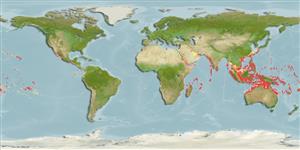Common names from other countries
>
Gobiiformes (Gobies) >
Gobiidae (Gobies) > Gobiinae
Etymology: Priolepis: Greek, prio = to saw + Greek,lepis = scale (Ref. 45335); cincta: Name from Latin cinctum, a girdle or belt, presumably referring to the banded color pattern; treated as a noun in apposition by Winterbotton & Burridge, 1993:2063 (Ref. 10753).
More on author: Regan.
Issue
Specific name to be examined, treated as a noun in apposition in Ref. 10753, but CofF treat the name as an adjective.
Environment: milieu / climate zone / depth range / distribution range
Ecología
marino; salobre asociado a arrecife; no migratorio; rango de profundidad 1 - 70 m (Ref. 2334), usually 1 - 30 m (Ref. 9002). Tropical; 32°N - 24°S
Indo-West Pacific: Red Sea, Persian Gulf and east coast of Africa to islands of Micronesia, Fiji and Tonga; Japan to Coral Sea.
Tamaño / Peso / Age
Maturity: Lm ? range ? - ? cm
Max length : 7.0 cm FL macho / no sexado; (Ref. 5525)
Short description
Claves de identificación | Morfología | Morfometría
Espinas dorsales (total) : 7 - 8; Radios blandos dorsales (total) : 11; Espinas anales: 1; Radios blandos anales: 9. Characterized by having alternating dark-edged brown and narrower white bars on head and body; dorsal and caudal fins with brown spotting; basal part of dorsal fins with dark spots/bands; longitudinal scale series 27-31; ctenoid scales on body except cycloid on abdomen, prepectoral and prepelvic areas; upper opercle with a patch of cycloid scales; cheek without scales; depth of body 3.8-4.6 in SL (Ref. 90102).
Hides in caves and crevices (Ref. 9710), also among corals or rock (Ref. 37816). Monogamous (Ref. 52884).
Life cycle and mating behavior
Maturities | Reproducción | Spawnings | Egg(s) | Fecundities | Larva
Benthic spawner (Ref. 31409). Bi-directional sex change was proposed for this species (Ref. 103751). Monogamous mating is observed as both obligate and social (Ref. 52884).
Randall, J.E., G.R. Allen and R.C. Steene, 1990. Fishes of the Great Barrier Reef and Coral Sea. University of Hawaii Press, Honolulu, Hawaii. 506 p. (Ref. 2334)
IUCN Red List Status (Ref. 130435)
Warning: mysqli::__construct(): (08004/1040): Too many connections in /var/www/html/includes/func_getlabel.php on line 46
Can't connect to MySQL database (fbapp). Errorcode: Too many connections
